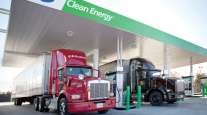Editorial: Paying at the Pump for Infrastructure
Transportation Secretary Elaine Chao kicked off Infrastructure Week with the hopeful message that the Trump Administration is keeping its options open for ways to pay for its planned 10-year, $1.5 trillion infrastructure program. But that message — and, perhaps, the very goal of the weeklong initiative itself — was somewhat offset by the reality that U.S. lawmakers likely won’t get anything done on infrastructure this year.
Participants said as much, and that includes some lawmakers. Concerns were raised that other issues will take precedent this year, or that the open nature of the discussion about funding mechanisms could actually serve as a barrier to progress by creating added uncertainty.
A fair point, but it’s also arguable that having more options increases the chances that one or more good solutions will emerge.
Chao in her comments listed increasing fuel taxes and expansion of public-private partnerships as possible sources of funding. But P3s tend to include tolling, which many in trucking view unfavorably.
Regardless of how the money is collected, the Trump infrastructure proposal only includes $200 million in dedicated funding; the bulk of the rest must be collected by states.
Chao also mentioned vehicle miles traveled fees, and on this point, some states are already ahead of the curve — several are currently running pilot tests.
Another option on the table — put forth by American Trucking Associations — is a fuel usage fee included in wholesale fuel prices and collected at the terminal rack.
Plenty of options. Which will carry the day?
Realistically, more than one. There is no one perfect solution; just as it will take the efforts of many to get an infrastructure plan moving forward, it will likely take a variety of funding mechanisms to pay for it.
Given the now eight-week stretch of consecutive increases in fuel prices, the notion of raising fuel taxes might be unpopular. But, these types of fluctuations in fuel prices are familiar and often fleeting. They’re just as likely to start falling as they are to continue rising. And businesses and drivers are pretty used to it. Fuel prices shift. They just do.
Given that, would some form of a graduated increase in fuel taxes really be felt? If a 5 cents per-gallon increase in diesel and gasoline were adopted tomorrow — with the revenue dedicated to infrastructure funding — would end-users really feel it? Or would it just get wrapped up in the usual sway of fuel prices? Barely noticed by users, but dedicated to fixing a problem most agree exists.
In some form or another, it’s an option worth serious consideration.




